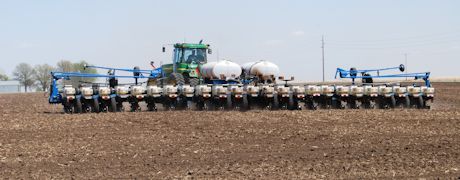April 14, 2015

Agronomists say you shouldn't plant corn until the soil temperature is 50 degrees F at the 4-inch depth. How important is that number when you look at the calendar and see it's the 15th of April?
Related: When to plant corn in central Midwest
"That's kind of a magic number, 50 degrees, for planting corn," observes Jim Fawcett, an Iowa State University Extension field agronomist in eastern Iowa. "That's when corn will germinate, with a soil temperature of 50 degrees or higher.
"The reason for not planting before that is the seed actually will take up water with soil temperatures cooler than 50 degrees. The seed will swell, but it doesn't germinate. That's not a good combination because the seed will tend to rot if it's just sitting there swelling in the soil but not germinating. The seed imbibes the water, takes it in, but doesn't germinate because it's too cold."
Fawcett adds, "Particularly in April, I would definitely be paying attention to soil temperature before I decide to plant corn."
As for timeline, the ideal corn planting window is April 20 to May 5 in Iowa. "A lot of farmers have big planters and enough help that they can get their corn acreage planted in 3 to 5 days. If you can do that, there's no sense in trying to push things along before soil conditions are right," Fawcett says.
Every decision that you make influences the size and scope for corn yields. From the corn hybrid you select to the seeding rate and row width you choose. Download our FREE report over Maximizing Your Corn Yield.
How long can seed sit in the ground waiting for soil to warm up to germinate?
How long will that seed wait in the ground? If you plant corn early, say during the first half of April, how long should you expect that seed to be good?
"That's part of the problem of putting it in too early," says Fawcett. "You can expect poorer stands and a lower plant population surviving when you do that because the seed will imbibe the water that is in the soil. And if you don't hit that 50 degree soil temperature soon, you will have some seed starting to rot. Also, it increases the chances of having other things happen, like fungal diseases moving in and damping-off occurring. It just puts more stress on the crop when you plant corn when the soil temperature is too cool."
Related: When is best date for planting corn?
Are farmers losing some carryover nitrogen? Can you count on carryover N?
After the 2012 drought, ISU Extension agronomists suggested farmers complete a soil test to check the nitrogen carryover in the top two or three feet of soil. But if there are heavy spring rains, will there be some nitrogen loss? Will farmers have to apply more fertilizer nitrogen than they had previously anticipated?
"You really need to be pulling some soil samples if you want to adjust your nitrogen fertilizer application rate this spring," Fawcett said. The time to that is after any heavy rains and before you apply nitrogen fertilizer. That allows you to see how much N is left in the soil.
For more corn news, corn crop scouting information and corn diseases to watch for, follow Tom Bechman's column, Corn Illustrated Weekly, published every Tuesday.
This story first appeared in April, 2013.
About the Author(s)
You May Also Like






